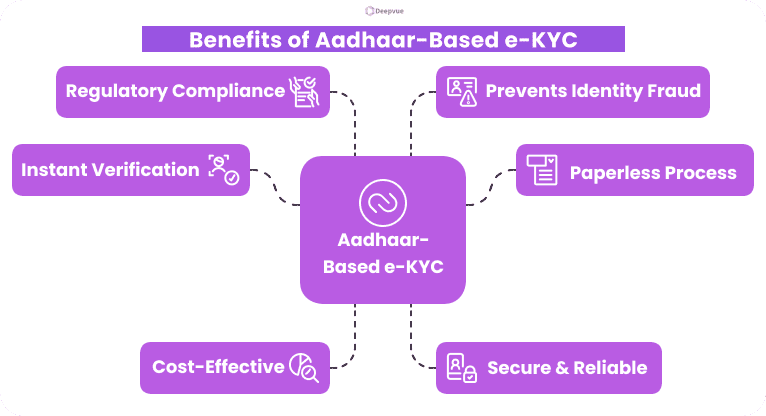Aadhaar OTP (One-Time Password) verification has come to play a crucial role in enhancing the security and dependability of internet-based transactions, particularly in the context of e-governance. Aadhaar, the Indian unique identification scheme, offers a mechanism through which citizens can digitally authenticate their identity, allowing for more convenience in the delivery of various government services ranging from subsidies to tax returns.
Aadhaar OTP authentication plays a crucial role in e-governance since it provides an easy but secure method for remotely authenticating a user’s identity without any physical documentation. The OTP received on the mobile number associated with a person’s Aadhaar confirms that the user requesting access to services is the actual beneficiary.
In this blog, we will explore how Aadhaar OTP authentication is shaping the future of e-governance, making it more secure, accessible, and user-friendly.
Importance of Aadhaar in Digital India
Aadhaar acts as the keystone of India’s digital revolution by assigning a unique 12-digit number to each citizen, assuring secure and authentic identity verification. It allows for easy access to government services, e-governance, and welfare schemes, eliminating fraud and duplication. Aadhaar promotes financial inclusion by simplifying the opening of bank accounts, access to digital payment systems, and subsidy delivery through Direct Benefit Transfers (DBT).
The e-KYC process using Aadhaar makes mobile connectivity verification, banking, and other vital services simple through identity verification without paperwork, increasing efficiency. It also facilitates the Aadhaar-enabled Payment System (AePS), enabling cashless transactions and contributing to a robust fintech ecosystem in India. Aadhaar linking with PAN prevents tax evasion and facilitates financial compliance.
In addition, Aadhaar improves cybersecurity through a secure digital identity, avoiding identity theft, and allowing remote access to services. Aadhaar empowers citizens with an effortless and technology-based identity system, making the government more transparent, efficient, and accessible.
Modes of Aadhaar Authentication
- Biometric Authentication: Uses fingerprints, iris scans, or face recognition to check identity.
- Digital Certificate: Employs encryption techniques in generating digital signatures.
- OTP Authentication: Sends an OTP to a registered mobile number or an email for verification.
- Demographics Authentication: Authenticates identity based on Aadhaar-linked individual information such as name, birth date, and address.
The Significance of Consent in Aadhaar Authentication
- Improved Security: Consent makes Aadhaar authentication utilized only when sanctioned by the user. It inhibits unauthorized use of individual data and reduces the risk of identity theft. With the express consent involved, it enhances security in OTP-based and biometric authentication.
- Data Privacy Assurance: User authorization guarantees that the Aadhaar information is utilized just for the explicit purpose. It aligns itself with data protection principles, eluding misuse and unauthorized disclosure. Transparent consent systems instill trust between users and service providers.
- User Consent in E-Governance: Aadhaar authentication of government services promotes accountability based on consent. It facilitates digital inclusion with the control of users over their own data. Authentication through consent assists in compliance with data protection laws and policies.
Advantages of Aadhaar in e-KYC

- Instant Verification: Aadhaar-based e-KYC facilitates real-time identification verification, minimizing processing time.
- Paperless Process: Does away with the requirement of physical documents, hence an efficient process.
- Cost-Effective: Saves on the administrative cost incurred in gathering, storing, and verifying documents.
- Secure & Reliable: Uses biometric and OTP authentication to prevent identity fraud.
- Regulatory Compliance: Adherence to the KYC guidelines prescribed by financial and telecom regulators in India.
- Prevents Identity Fraud: Reduces risks of fake documents and impersonation.
Aadhaar OTP Authentication Challenges and Issues
- Delayed or Non-Receipt of OTP: The users can be delayed in receiving the OTP because of network problems, server outages, or wrong mobile number linking.
- OTP Expiration: The Aadhaar OTP has a limited duration within which it expires, and procrastination causes it to expire before it can be used.
- Repeated Failed Attempts Leading to Lockouts: There could be multiple failed OTP requests resulting in short-term Aadhaar authentication lockouts.
- Security and Fraud Risks: Phishing and fake OTP requests can lead to identity theft or unauthorized access.
Future of Aadhaar e-KYC OTP Authentication
- Increased Security Features: Better encryption and machine learning-based fraud detection to guard against abuse.
- Multi-Factor Authentication (MFA): Aadhaar e-KYC OTP possesses biometrics or device-based multi-factor authentication solutions to enhance the level of security.
- Offline Aadhaar Verification: Scaling up tokenized and QR code-based authentication to reduce dependence on OTP.
- Integration with Decentralized Identity Systems: Blockchain utilization can potentially utilize Aadhaar authentication to be tamper-proof.
Ongoing Developments in E-Governance
- Unified Digital Identity: Ease of integration of Aadhaar with other government services to enable single-window authentication.
- Extension of Aadhaar-Based Services: A large number of industries, such as banking, medical, and education, use Aadhaar authentication.
- AI-Driven Governance: AI-based chatbots and intelligent systems to enhance citizen service provision.
- Interoperability Across Departments: Enhancing data-sharing frameworks for effective governance.
- Stronger Cybersecurity Policies: Government measures to guarantee data protection and security in electronic verification.
Conclusion: The Transformative Role of Aadhaar in E-Governance
Aadhaar OTP authentication has transformed e-Governance by offering a safe, affordable, and easy means of identity authentication. Aadhaar OTP authentication will continue to be a pillar of India’s drive towards a more transparent and citizen-friendly administration. Ensuring strong data protection protocols and allaying privacy fears will be the key to unlocking its long-term potential.
Our Aadhaar Verification API offers a seamless and secure solution for verifying Aadhaar card details in real time. With easy integration, companies and service providers can verify the identity of people by checking their Aadhaar information against official documents.
FAQ:
What is the purpose of Aadhaar authentication?
Aadhaar authentication authenticates a person’s identity with their Aadhaar number and biometric information to provide secure and correct access to services.
What is Aadhaar OTP used for?
Aadhaar OTP is a one-time password that is sent to a registered mobile number, providing an additional layer of security for online transaction authentication.
What is Aadhaar OTP-based E-KYC?
Aadhaar E-KYC OTP allows remote identity verification using Aadhaar and OTP, enabling faster and paperless customer verification for services like banking and telecom.
What is the use of the Aadhaar number in digital services?
Aadhaar number is employed in secure authentication for online services such as banking, government schemes, and e-filing of taxes, for trustworthy verification of identity.
How to Manage Accounts in e-Pramaan?
To operate accounts in e-Pramaan, use Aadhaar login credentials, make changes to personal information, access government services or monitor application status securely.








